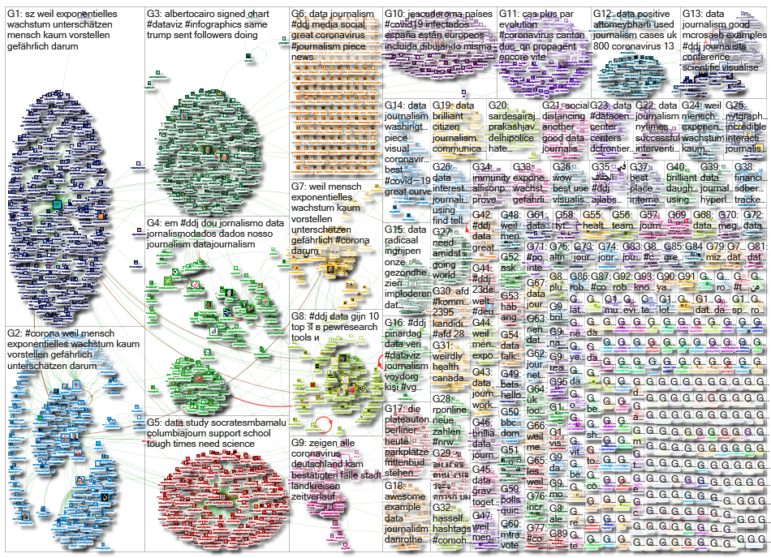The novel coronavirus is dominating Twitter chatter among the global data journalism community this week. Our NodeXL #ddj mapping from March 9 to 15 finds The Washington Post simulating social distancing scenarios and their effects on slowing the spread of COVID-19, the South China Morning Post highlighting research into a cluster case, Süddeutsche Zeitung charting exponential growth in countries with high infection rates, and The New York Times spotlighting jobs that put workers at greatest risk of contracting the virus.
How to Slow the Spread of COVID-19
This Washington Post piece emphasizes the importance of social distancing measures in slowing down the spread of the coronavirus. By using bouncing balls, it simulates what could happen in four movement scenarios: a free-for-all, attempted quarantine, moderate social distancing, and extensive social distancing. The simulations were done with Canvas API and the charts are made in SVG with D3.js.
A very informative and easy to digest article on how to #FlattenTheCurve, slow the spread of coronavirus, and how such attempts save lives. Fantastic article. https://t.co/e5gNsr7tw7
— Kumail Nanjiani (@kumailn) March 16, 2020
How COVID-19 Spread in a Bus
According to the South China Morning Post, a group of researchers from Hunan province investigating a COVID-19 cluster case discovered that a bus passenger managed to infect fellow travelers sitting 4.5 meters away. This is further than the official “safe distance” of one to two meters advised by authorities. The article also advocates the wearing of masks for the public, which is at odds with advice by other medical experts about the masks’ effectiveness in prevention of infection.
Researchers have found that a bus passenger managed to infect others seated as far as 4.5 metres away. Most were not wearing a mask. Read more here: https://t.co/5I0PuNTelm pic.twitter.com/ojQsEaKTPm
— SCMP News (@SCMPNews) March 10, 2020
Flattening the Curve
German daily Süddeutsche Zeitung charted the increase in number of cases in countries with high rates of infection, such as South Korea, Italy, France and Germany, to show a trend of exponential growth in cases, and to emphasize the importance of “flattening the curve” — diminishing the rate at which new cases occur. If the spread of the novel coronavirus is not slowed down with countermeasures, more than a million people in Germany could be infected with the virus by mid-May, they report. More coronavirus-related data stories are listed here. (In German.)
Awesome interactive article about exponential growth and why it's important for fighting #COVID19 in Germany and worldwide.#FlattenTheCurve. by @c_endt
https://t.co/HsHKljXPKG— Idris Nematpur (@IdrisNobel) March 12, 2020
Jobs with Greatest Risk of Exposure
Which jobs put workers at the greatest risk of contracting the coronavirus? The New York Times tried to figure that out by calculating risk levels of various jobs using O*NET, a database maintained by the Department of Labor that describes various physical aspects of different occupations. Hint: it’s not a great time to be a dentist or paramedic.
Great article identifies occupations at greatest risk to #COVID19; those with the greatest exposure to diseases; those who work in closest proximity to others; those with greatest numbers; & those with lowest wages who lack paid leave. #FlattenTheCurve https://t.co/GiKZGnF98L
— Kim Perrotta (@KimPerrotta57) March 17, 2020
Trump Cherry-Picking Charts
Alberto Cairo, Knight Chair in Visual Journalism at the University of Miami, blogs about how US President Donald Trump conveniently cherry-picked statistics to suggest that stock markets experienced a rapid recovery after his press conference on the coronavirus. Cairo explains how the chart shown by Trump is misleading and only a small part of the big picture.
Context matters!
🙌 @AlbertoCairo 🔗 https://t.co/oFIjKFJuVt pic.twitter.com/2WDdeOtajY
— RJ Andrews (@infowetrust) March 16, 2020
Rates and Proportions in Charts
Business analytics and data visualization expert Kaiser Fung critiques a chart from Ars Technica that confuses rates and proportions. He explains the problem and suggests a way to improve the chart.
They didn't use a dual axis (good). So, why is this axis hard to interpret? https://t.co/3AIa8rLTYU #junkcharts #COVID-19 #dataviz #proportions #rates pic.twitter.com/zikZccXN0m
— Kaiser Fung (@junkcharts) March 12, 2020
Data Analysis in Your Browser
If you’re interested in Python, R, or JavaScript, check out some online tools and services recommended by Alex Richards, assistant professor at Syracuse University, at NICAR20.
Data analysis in your browser: Google Colab, Binder, Microsoft Azure, Kaggle, RStudio Cloud & more! The full #nicar20 presentation by @alexrichards covering #python, #rstats and #javascript is at https://t.co/38wQq53ZlF
— Sharon Machlis (@sharon000) March 5, 2020
Lost Parts of Berlin
The historic city of Berlin-Cölln used to hold more than 1,200 buildings, but most of them were demolished or bombed. Only 85 remain. On the occasion of the hundredth birthday of Greater Berlin, Der Tagesspiegel dug into map archives to compare the current Berlin to the old city before the Second World War.
'Berlins verlorene Mitte': a wonderful interactive guide to the streets and squares in the middle of Berlin that used to pulse with life https://t.co/ATPXlycIla via @Tagesspiegel
— German at Portsmouth (@GermanAtPompey) March 11, 2020
Drop in Brazil’s Social Benefits
Núcleo Jornalismo analyzes available official data on Brazil’s Bolsa Família social benefits program to see how it has developed under President Jair Bolsonaro’s tenure. It found a 7.3% drop in the number of families benefiting from the program.
Publicamos hoje no @nucleojor análise com dados do Bolsa Família, e constatamos queda de 7,3% no número de famílias beneficiadas pelo programa nos 12 meses encerrados em novembro de 2019. Se consideramos o comparativo entre jan-nov.2019, a queda é 4,1%.https://t.co/Qc1oNF6o1D pic.twitter.com/NpGnNUtzDa
— Sérgio Spagnuolo (@sergiospagnuolo) March 3, 2020
Data Journalism Course (In Russian)
Need a data journalism course in Russian? Strelka Institute for Media, Architecture and Design is organizing one from March 27 to April 12 for journalists, bloggers, analysts, and media managers who do not know programming, but who want to create stories based on data. Applications will be accepted until March 23.
Составила не просто так, а потому, что с @dorozhnij и @strelkamagazine уже через две с половиной недели делаем 70-часовой курс по журналистике данных, где будем учить строить и проверять гипотезы в историях, основанных на данных https://t.co/TFg0dVe0i7
— dada lyndell (@dadalndll) March 13, 2020
Thanks again to Marc Smith of Connected Action for gathering the links and graphing them. The Top Ten #ddj list is curated weekly.
 Eunice Au is GIJN’s program coordinator. Previously, she was a Malaysia correspondent for Singapore’s The Straits Times, and a journalist at the New Straits Times. She has also written for The Sun, Malaysian Today, and Madam Chair.
Eunice Au is GIJN’s program coordinator. Previously, she was a Malaysia correspondent for Singapore’s The Straits Times, and a journalist at the New Straits Times. She has also written for The Sun, Malaysian Today, and Madam Chair.

